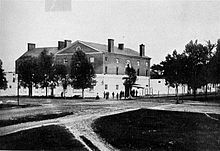Fifteenth United States Congress
| 15th United States Congress | |
|---|---|
|
14th ←
→ 16th
|
|

The Old Brick Capitol, the temporary Capitol while the U.S. Capitol was being renovated after the Burning of Washington. (pictured here around 1861 in use as a Civil War prison)
|
|
| March 4, 1817 – March 4, 1819 | |
| Senate President | Daniel D. Tompkins (DR) |
| Senate Pres. pro tem | James Barbour (DR) |
| House Speaker | Henry Clay (DR) |
| Members | 42 Senators 185 Representatives 3 Non-voting members |
| Senate Majority | Democratic-Republican |
| House Majority | Democratic-Republican |
| Sessions | |
|
Special: March 4, 1817 – March 6, 1817 1st: December 1, 1817 – April 20, 1818 2nd: November 16, 1818 – March 3, 1819 |
|
The Fifteenth United States Congress was a meeting of the legislative branch of the United States federal government, consisting of the United States Senate and the United States House of Representatives. It met in the Old Brick Capitol in Washington, D.C. from March 4, 1817, to March 4, 1819, during the first two years of James Monroe's presidency. The apportionment of seats in the House of Representatives was based on the Third Census of the United States in 1810. Both chambers had a Democratic-Republican majority.
The count below identifies party affiliations at the beginning of the first session of this congress. Changes resulting from subsequent replacements are shown below in the "Changes in membership" section.
During this congress, two Senate seats were added for each of the new states of Mississippi and Illinois.
During this congress, one House seat was added for each of the new states of Mississippi and Illinois.
This list is arranged by chamber, then by state. Senators are listed in order of seniority, and Representatives are listed by district.
Senators were elected by the state legislatures every two years, with one-third beginning new six-year terms with each Congress. Preceding the names in the list below are Senate class numbers, which indicate the cycle of their election. In this Congress, Class 1 meant their term began in the last Congress, requiring reelection in 1820; Class 2 meant their term began with this Congress, requiring reelection in 1822; and Class 3 meant their term ended with this Congress, requiring reelection in 1818.
The names of members of the House of Representatives are preceded by their district numbers.
All representatives were elected statewide on a general ticket.
(6 Federalists)
Both representatives were elected statewide on a general ticket.
(2-2 split)
...
Wikipedia
